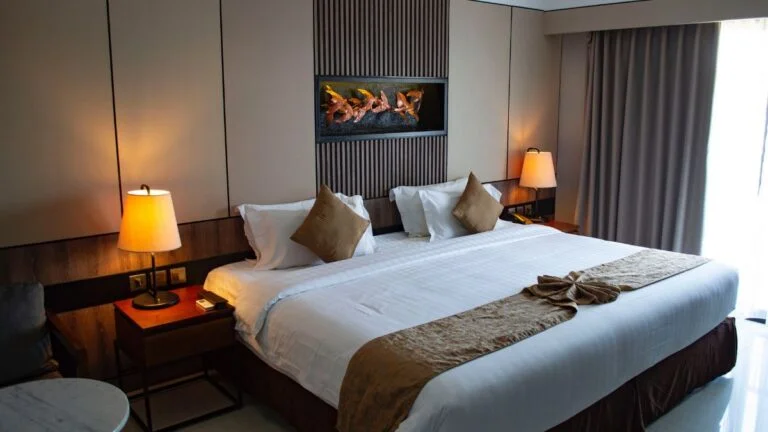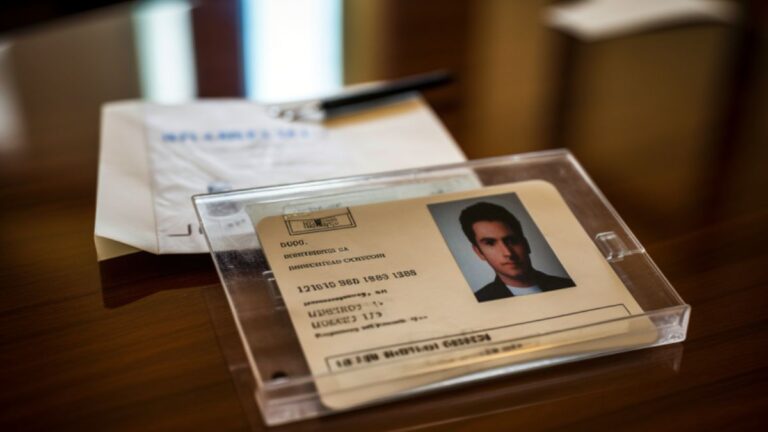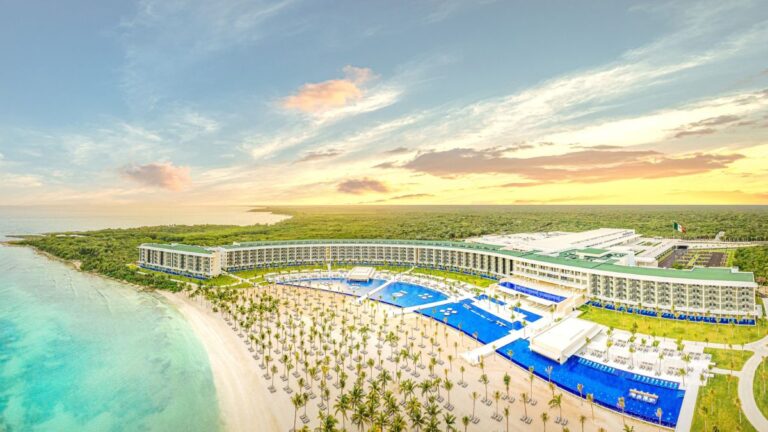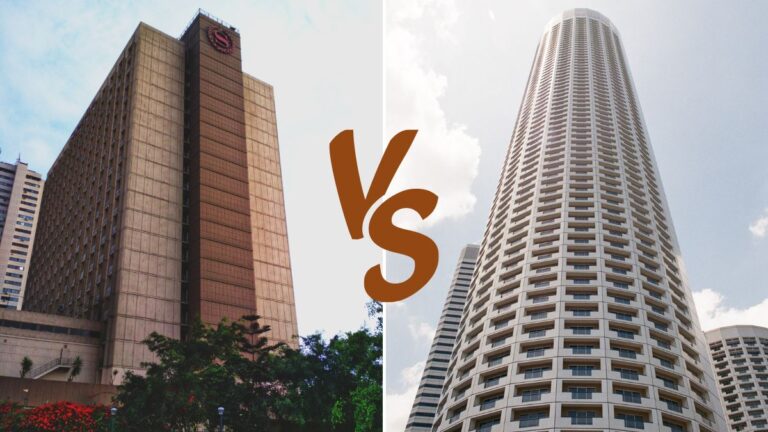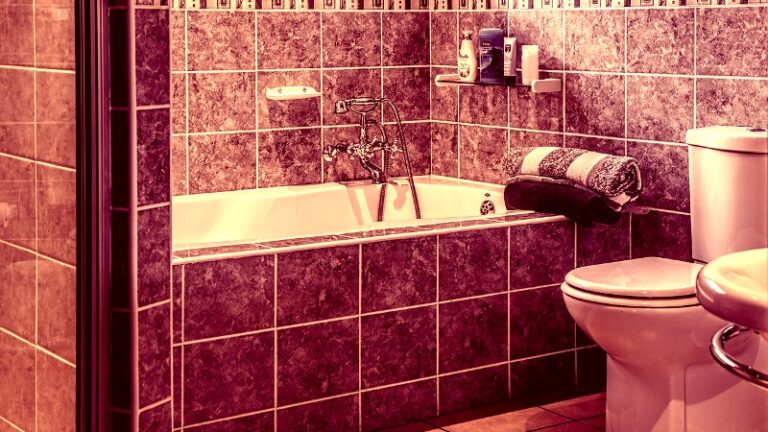Why Do All Hotel Rooms Look the Same? Exploring the Uniformity of Hospitality Design
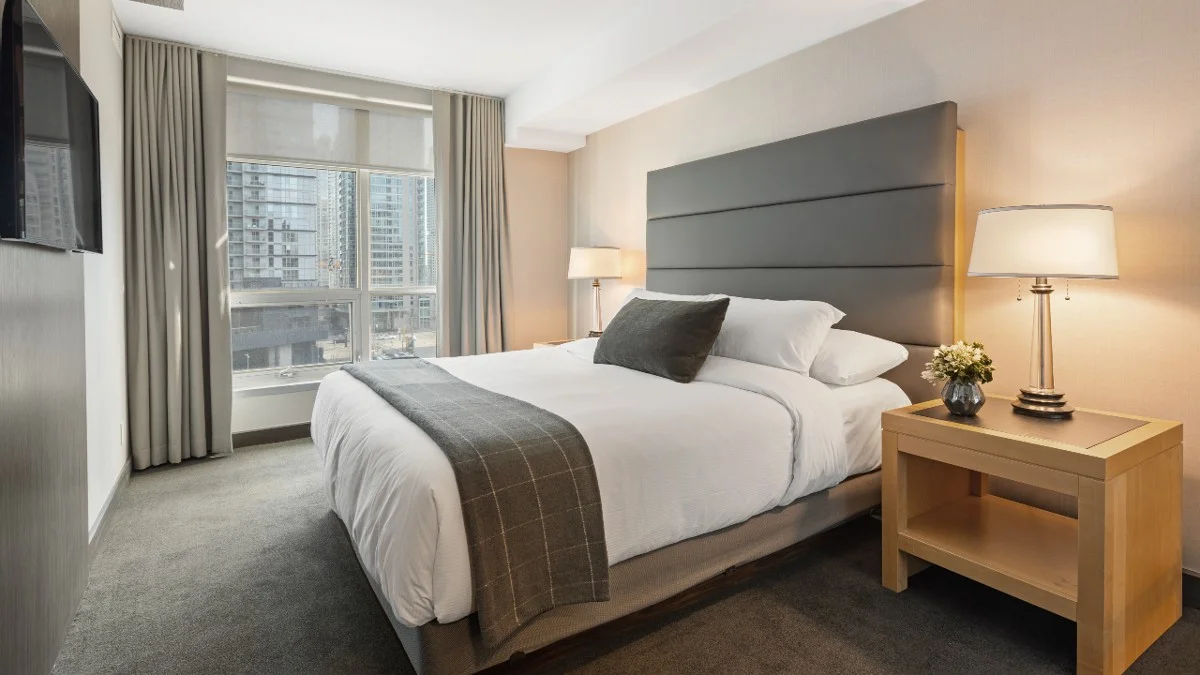
As participants in Amazon Associates and other programs, we earn from qualifying purchases. This comes at no additional cost to you. For more details, see our Affiliate Disclosure.
Step into any hotel room, and a sense of familiarity washes over you. The neutral tones, standardized furniture arrangements, and repetitive design elements make it difficult to distinguish one hotel room from another. It begs the question, why do all hotel rooms look the same?
The homogeneity of hospitality design has become a widely recognized phenomenon, raising curiosity and prompting a deeper exploration into the underlying factors that contribute to this uniformity.
In this article, we delve into the world of hotel room design, examining the various influences and considerations that shape the familiar aesthetics found in hotels worldwide. Prepare to unravel the mystery behind the striking similarity of these transient spaces and gain insight into the intriguing world of hospitality design.
Tracing the Origins of Standardized Hotel Room Design
Tracing the origins of standardized hotel room design reveals fascinating insights into the evolution of hospitality. In the mid-19th century, as travel became more accessible and hotels emerged as popular accommodation options, the need for a consistent and efficient approach to room design arose. Initially, hotels were predominantly catering to the wealthy and offered luxurious amenities, but as the demand for accommodations grew, a more standardized approach became necessary.
The advent of railway travel further accelerated the need for standardized hotel rooms. As train networks expanded, travelers sought convenient and predictable lodging options at their destinations. This led to the development of large hotel chains, which recognized the value of creating a consistent guest experience across multiple locations.
The Industrial Revolution also played a pivotal role in shaping standardized hotel room design, as it brought advancements in manufacturing, transportation, and construction techniques. These advancements made it easier and more cost-effective to produce and replicate furnishings, fixtures, and room layouts, enabling hotels to achieve a uniform aesthetic and functionality across their properties.
Guest Expectations and Comfort: Balancing Familiarity and Functionality
When it comes to hotel room design, guest expectations and comfort play a crucial role in striking a delicate balance between familiarity and functionality. Guests seek a sense of familiarity when they enter a hotel room—a space that is comfortable and provides a predictable experience. This familiarity can be attributed to the standardized design elements found across various hotels, ensuring that guests feel at ease regardless of their destination.
Functionality is another key aspect that hotel designers must consider. Hotel rooms are designed to cater to the needs and preferences of a diverse range of guests, accommodating their daily routines and providing essential amenities. The layout, furniture arrangement, and placement of amenities must be carefully thought out to ensure ease of use and convenience. From the positioning of the bed and desk to the placement of power outlets and lighting controls, every detail contributes to creating a functional and efficient space for guests.
However, achieving the right balance between familiarity and functionality is no easy task. While guests appreciate a consistent experience, there is also a desire for individuality and unique touches that make each hotel stand out. Designers face the challenge of incorporating personalized elements without compromising the overall comfort and functionality of the room. Striving for a balance that meets guest expectations while providing a comfortable and functional space is a constant endeavor in the realm of hotel room design.
Efficiency and Cost-Effectiveness: The Business Behind Uniform Room Design
Efficiency and cost-effectiveness are significant drivers behind the uniform room design seen in hotels worldwide. Hoteliers understand the importance of optimizing their operations to maximize profitability and deliver a consistent experience to guests. By adopting standardized room designs, hotels can streamline their processes and achieve operational efficiencies.
One aspect of efficiency lies in the ease of maintenance and housekeeping. When hotel rooms have consistent layouts, fixtures, and furnishings, it becomes simpler for housekeeping staff to clean and maintain them. Uniform designs reduce the time and effort required to prepare a room for the next guest, allowing for quicker turnaround times and increased room availability.
Cost-effectiveness also plays a pivotal role in shaping uniform room design. Hotels often operate on tight budgets and need to make strategic decisions to minimize expenses. By utilizing standardized designs, hotels can benefit from economies of scale.
They can negotiate better deals with suppliers for bulk purchases of furniture, fixtures, and equipment, reducing procurement costs. Additionally, with a uniform design, hotels can efficiently manage their inventory, as they know precisely what items are needed for each room type, eliminating the need for excessive variety and reducing storage costs.
Furthermore, uniform room designs simplify staff training processes. When rooms follow a standardized layout, employees can quickly familiarize themselves with the setup and provide consistent service to guests. This helps maintain service quality and reduces training time, leading to cost savings in the long run.
While efficiency and cost-effectiveness are key considerations for hotel owners, it is important to strike a balance between these factors and guest satisfaction. Hotels must ensure that standardized designs do not compromise guest comfort and experience, as ultimately, guest satisfaction is the foundation of a successful hospitality business.
Branding and Identity: Maintaining Consistency Across Hotel Chains
Maintaining consistency across hotel chains is a vital aspect of branding and identity. Hotel chains invest significant effort in creating a distinct brand image that resonates with their target audience. Consistency in room design plays a crucial role in reinforcing this brand identity and establishing a recognizable experience for guests, regardless of the location they visit.
- Brand Recognition: By adopting a uniform room design, hotel chains enhance brand recognition as guests can easily identify their properties based on the familiar aesthetics and layout.
- Brand Cohesion: Consistency in room design ensures a cohesive experience across different locations, reinforcing the brand’s values, ambiance, and overall identity.
- Guest Loyalty: A consistent experience can foster guest loyalty, as guests who have positive experiences in one property are likely to choose the same brand in the future, expecting a similar experience.
- Market Positioning: Uniform room design allows hotel chains to position themselves within a specific market segment, whether it’s luxury, budget, or boutique, by incorporating design elements that align with their target market’s expectations.
- Franchise Operations: For hotels operating under a franchise model, maintaining a consistent room design is crucial for upholding the brand standards and ensuring a consistent experience for guests.
Maintaining consistency in room design across hotel chains is instrumental in strengthening brand recognition, fostering guest loyalty, and positioning the brand effectively within the competitive hospitality industry.
Globalization and International Standards: The Impact of Homogeneity in Hospitality Design
The impact of homogeneity in hospitality design, driven by globalization and international standards, has transformed the landscape of the hotel industry. As travel becomes increasingly globalized and guests from diverse cultural backgrounds seek accommodations worldwide, the need for standardized designs has become paramount. Here are several key aspects highlighting the impact of homogeneity in hospitality design:
- Accessibility and Familiarity: Standardized hotel room designs offer a familiar and predictable experience for travelers, regardless of their destination. Guests appreciate the convenience of navigating and understanding the layout of their rooms, irrespective of the country or culture they are in.
- Brand Consistency: International hotel chains rely on standardized designs to maintain brand consistency across their global portfolio. Whether a guest stays in a hotel in New York, Tokyo, or Dubai, they expect a consistent level of service and design that aligns with the brand’s identity.
- Efficient Operations: Standardized room designs streamline operations for hotel chains operating on a global scale. From procurement to maintenance and training, having consistent designs allows for efficient management across multiple properties, reducing costs and ensuring a seamless experience for both guests and staff.
- International Travelers’ Expectations: International travelers often have specific expectations and preferences when it comes to hotel accommodations. Homogeneous designs cater to these expectations by providing standardized amenities, technology, and layouts that are familiar and functional to a global audience.
- Harmonization of Quality Standards: International standards and regulations play a significant role in shaping hotel design. Homogeneous designs help hoteliers meet and adhere to these standards, ensuring compliance with safety, accessibility, and sustainability requirements across different countries and regions.
- Loss of Local Identity: While homogeneity brings benefits in terms of efficiency and consistency, there is a risk of diluting or eroding the unique local identity and cultural nuances that can enrich the guest experience. Balancing global standards with local elements becomes crucial to retain a sense of place and authenticity.
The impact of homogeneity in hospitality design, driven by globalization and international standards, has reshaped the industry by offering accessibility, efficiency, and brand consistency. However, it also poses the challenge of preserving local identity and catering to the diverse preferences of travelers seeking unique cultural experiences.
Psychological Factors: The Role of Familiarity in Guest Satisfaction
The role of familiarity in guest satisfaction cannot be underestimated when it comes to hotel room design. Familiarity plays a significant psychological role in shaping guests’ perception and overall satisfaction with their hotel experience. Here are several key factors highlighting the importance of familiarity in guest satisfaction:
- Comfort and Relaxation: Familiarity breeds a sense of comfort and relaxation. When guests enter a hotel room that feels familiar, they experience a sense of ease and comfort, allowing them to unwind and feel at home, even when they are away.
- Cognitive Ease: Familiarity creates cognitive ease, which refers to the mental effort required to process information. When guests encounter familiar design elements, such as a standardized layout or commonly found amenities, their cognitive load is reduced, leading to a more positive and effortless experience.
- Expectation Alignment: Familiarity aligns with guests’ expectations. Many guests have a preconceived notion of what a hotel room should look like based on their previous experiences or exposure to media representations. When their expectations are met or exceeded, it enhances their satisfaction and creates a positive impression of the hotel.
- Emotional Comfort: Familiarity evokes positive emotions. Guests often seek comfort in familiarity, as it provides a sense of security and predictability. When a hotel room design feels familiar, it triggers positive emotions associated with previous positive experiences, contributing to guest satisfaction.
- Perceived Quality: Familiarity can influence perceived quality. Guests associate familiarity with reliability and quality. When a hotel room design feels familiar, it can create a perception of high quality and attention to detail, even if the actual design elements are relatively simple or standard.
- Repeat Business and Loyalty: Familiarity is closely tied to repeat business and guest loyalty. Guests who have had positive experiences with familiar hotel room designs are more likely to choose the same hotel or brand in the future. Familiarity builds trust and a sense of loyalty, fostering long-term relationships with guests.
Familiarity plays a crucial role in guest satisfaction by providing comfort, aligning with expectations, reducing cognitive load, and evoking positive emotions. Hotel room designs that incorporate familiar elements contribute to a positive guest experience, enhance perceived quality, and foster repeat business and guest loyalty.
Design Trends and Market Demand: Exploring the Popularity of Standardized Aesthetics
Exploring the popularity of standardized aesthetics in hotel room design requires an examination of design trends and market demand. Design trends influence the direction of the hospitality industry, reflecting the preferences and expectations of modern travelers. Here are key factors shedding light on the popularity of standardized aesthetics:
- Contemporary Appeal: Standardized aesthetics often align with contemporary design trends, which emphasize clean lines, minimalist aesthetics, and a neutral color palette. This modern and sleek approach to design resonates with a wide range of travelers seeking a fresh and sophisticated ambiance.
- Mass Market Appeal: Standardized aesthetics cater to the mass market, appealing to a broad spectrum of guests with varying tastes and preferences. By adopting design elements that are widely accepted and familiar, hotels can attract a larger customer base and achieve wider market appeal.
- Brand Cohesion: Standardized aesthetics contribute to brand cohesion within hotel chains. By implementing consistent design elements across their properties, hotel brands create a cohesive and recognizable identity. This consistency helps guests feel connected to the brand, regardless of the location they choose to stay in.
- Ease of Replication: Standardized aesthetics are often practical and easy to replicate across multiple properties. This ease of replication benefits hotel chains, as it allows for efficient implementation and maintenance of design standards, regardless of the geographical location.
- Timelessness and Longevity: Standardized aesthetics often incorporate timeless design elements that withstand the test of time. By avoiding overly trendy or niche design choices, hotels can ensure that their rooms remain visually appealing and relevant for an extended period. This longevity is advantageous in terms of cost-effectiveness and maintaining guest satisfaction over time.
- Flexibility and Adaptability: Standardized aesthetics offer flexibility and adaptability to meet evolving market demands. While the core design elements remain consistent, hotels can incorporate small variations or modular features to cater to specific regional or cultural preferences, allowing for customization without compromising the overall standardized aesthetic.
The popularity of standardized aesthetics in hotel room design can be attributed to their contemporary appeal, mass market appeal, brand cohesion, ease of replication, timelessness, and flexibility. By aligning with design trends and meeting market demand, standardized aesthetics continue to be a preferred choice for hotels seeking to create visually appealing and widely accepted guest experiences.
Architectural Limitations and Space Optimization: Constraints in Hotel Room Design
Architectural limitations and space optimization present significant challenges in hotel room design. When designing hotel rooms, architects and designers must navigate existing structural constraints and optimize available space to create functional and appealing accommodations. Here are key considerations highlighting the constraints and strategies involved in hotel room design:
- Structural Constraints: Existing buildings or architectural structures may impose limitations on the layout and design of hotel rooms. Structural elements, such as load-bearing walls, columns, or irregular floor plans, need to be taken into account during the design process. Architects must work within these constraints to optimize the use of space effectively.
- Space Efficiency: Hotel rooms are often compact, and maximizing space efficiency is essential. Designers employ various strategies, such as utilizing multifunctional furniture, incorporating built-in storage solutions, and employing clever room layouts to optimize every square inch. Maximizing space efficiency ensures that guests have sufficient room for movement and that essential amenities are provided without compromising comfort.
- Traffic Flow: Creating a smooth and intuitive traffic flow within the limited space of a hotel room is crucial. Designers must consider the logical placement of furniture, fixtures, and amenities to ensure guests can navigate the room easily. Attention is given to the positioning of the bed, desk, bathroom, and storage areas to facilitate a seamless flow and avoid any obstructions.
- Natural Light and Views: Incorporating natural light and optimizing views can be challenging, especially in urban environments or when dealing with limited window placement. Designers need to strategically position windows, use reflective surfaces, and employ lighting techniques to enhance the perception of space and create a welcoming atmosphere within the room.
- Universal Accessibility: Hotel room design must also address the needs of guests with disabilities or mobility limitations. Designers must consider features such as wider doorways, accessible bathrooms, grab bars, and other elements that ensure universal accessibility without compromising the overall aesthetics and functionality of the room.
- Compliance with Regulations: Hotel room designs must adhere to local building codes and regulations related to fire safety, ventilation, electrical systems, and other essential aspects. Compliance with these regulations may pose additional constraints on design choices, necessitating creative solutions to meet both functional and regulatory requirements.
Architectural limitations and space optimization pose challenges in hotel room design. By creatively addressing structural constraints, maximizing space efficiency, ensuring smooth traffic flow, incorporating natural light, considering accessibility, and complying with regulations, designers can overcome these challenges and create well-designed hotel rooms that provide a comfortable and enjoyable experience for guests.
Guest Experience vs. Individuality: Balancing Personalization and Consistency
Balancing guest experience and individuality is a delicate task in hotel room design. On one hand, guests seek unique and personalized experiences that cater to their specific preferences and needs. On the other hand, hotels strive for consistency across their properties to maintain brand identity and deliver a consistent level of service. Finding the right balance between personalization and consistency is essential to create memorable guest experiences while upholding the desired brand image.
Personalization enhances the guest experience by making them feel valued and attended to on an individual level. Hotels can incorporate personalization through elements such as customized amenities, tailored room layouts, or unique design features that reflect the local culture or theme. Personal touches that acknowledge guests’ preferences or special occasions can leave a lasting impression and foster a sense of loyalty.
However, it is crucial to strike a balance to avoid overwhelming guests with excessive personalization, as it can detract from the overall guest experience and make the design feel disjointed.
Consistency, on the other hand, ensures that guests receive a reliable and predictable experience regardless of the hotel’s location. Consistent room design, amenities, and service standards build trust and familiarity. Guests who have positive experiences at one property within a hotel chain expect a similar experience when they visit another property of the same brand.
Consistency also supports operational efficiency, as standardized room designs streamline housekeeping, maintenance, and training processes. However, a strict adherence to consistency may risk creating a generic and impersonal atmosphere, lacking the charm and character that can enhance the guest experience.
The key to balancing personalization and consistency lies in strategic design choices. Hotels can adopt flexible design frameworks that allow for customization within a standardized structure. This may involve providing options for guests to choose from, such as pillow preferences, room layouts, or amenity selections.
Implementing technology solutions, like guest profiles or mobile apps, can enable guests to personalize their experiences while maintaining consistency in core design elements. It is essential for hotels to understand their target audience and brand positioning to strike the right balance between personalization and consistency, ultimately creating an exceptional guest experience that is both memorable and aligned with their brand identity.

